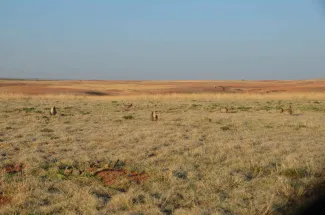
The lesser prairie-chicken has long received attention for its brilliant displays and, more recently, for its tenuous conservation status. The bird was first added to the Federal List of Endangered and Threatened Wildlife as “Threatened” in 2014, but was removed from the list after a 2016 court ruling. A new federal listing decision from the U.S. Fish and Wildlife Service is expected by the end of May 2021.
The lesser prairie-chicken is a ground-nesting upland prairie grouse species that lives in open grasslands with some shrub cover. In Oklahoma, it is restricted to our northwestern grasslands. Research shows the bird prefers native Conservation Reserve Program grasslands and avoids overgrazed ground. The male is very vocal in the spring when small groups congregate to perform a wonderful mating dance in attempts of impressing hens. The bird tends to avoid areas of human activity and vertical structures. Biologists believe this aversion to structures stems from predators like raptors using the structures as hunting perches.
Lesser prairie-chicken habitat is managed by several entities, including private landowners, state and federal agencies, and other conservation organizations. To help offset threats to the bird, like rangeland conversion to cropland, eastern redcedar encroachment, and petroleum and wind energy development, the Wildlife Department has partnered with these entities in Oklahoma and across the rest of the bird’s range in Colorado, Kansas, New Mexico and Texas. Models have been created to assist in siting energy projects, and best management practices have been developed and shared across the range.
To better understand the bird and its status in the state, the Wildlife Department conducts surveys each spring by ground and helicopter, partners with academics to pursue research opportunities, and has worked with landowners and conservation groups to develop conservation plans. Technical and limited financial assistance is available through the Wildlife Department to help with eastern redcedar removal and other practices. The Wildlife Department also promotes the use of prescribed fire and encourages landowners to reach out to Prescribed Burn Associations in their area for help in using prescribed fire to manage redcedars and enhance habitat for lesser prairie-chickens, northern bobwhites and other grassland-obligate species.
The Wildlife Department also administers a permit from the U.S. Fish and Wildlife Service for an Oklahoma Agricultural Candidate Conservation Agreement with Assurances, also known as a CCAA. This voluntary program helps landowners continue to manage their land without any changes in the event the lesser prairie-chicken again becomes a listed species. Grazing management is included within the program, often using grazing exclosures to assist landowners visualize the “take half, leave half” grazing strategy so that grass structure remains for the following spring nesting season. Voluntary landowner enrollment is open; contact Brett Cooper at (405) 740-9830 for more information.